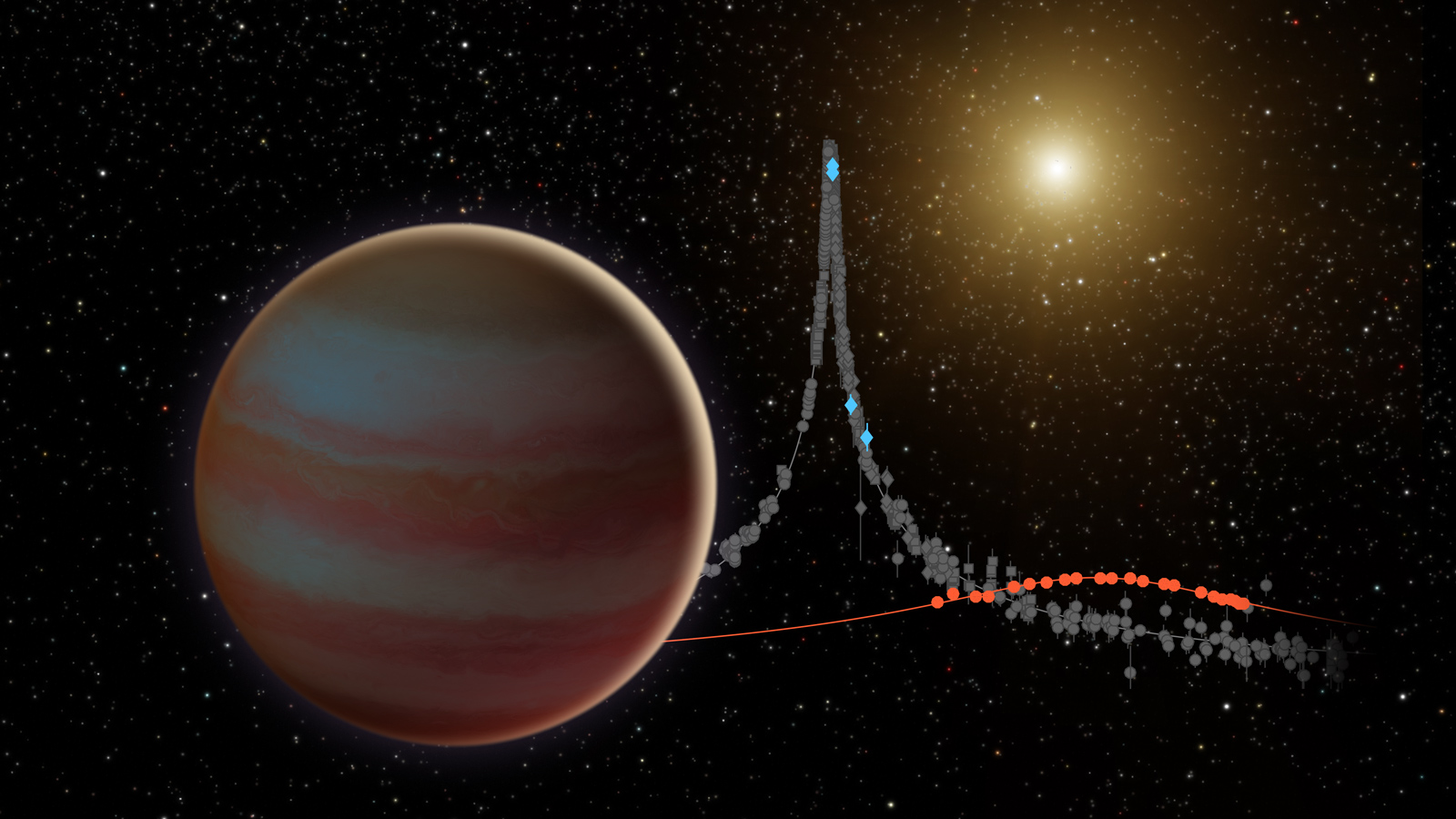Astronomers Have Decoded a Weird Signal Coming from a Strange, 3-Body Star System

Once or twice a day, a strange object in the Milky Way blinks at us. Now, astronomers think they know why.
The object is called NGTS-7, and to most telescopes it looks like a single star. Researchers at the University of Warwick in England started watching because it seemed to be emitting flares, but on closer examination they noticed that its starlight dims briefly every 16.2 hours. When the astronomers zoomed in, they realized there are actually two similarly sized stars in the system, and that only one of them is dimming briefly in that way — suggesting that there's something dark circling on or just above the star's surface. Now, in a paper posted to the preprint journal arXiv, the astronomers offer an explanation: A brown dwarf is orbiting one of the stars, in an orbit so tight that it takes just 16.2 hours to complete.
It's impressive that the astronomers involved were able to parse the complicated signal from this system, disentangling where the intermixed light from the brown dwarf and the two small, young stars originally came from, said Hugh Osborn, an astronomer at the Laboratoire d'Astrophysique de Marseille in France, who was not involved in the research. [11 Fascinating Facts About Our Milky Way Galaxy]
To pull it off, the researchers applied a similar technique to that used to detect exoplanets: Measuring how the light dipped as the brown dwarf passed between its host star and Earth. This dip represents the signal of a "transit": a brief, partial eclipse of the star by something too small and dim to see directly, even through a powerful telescope.
"Detecting this system is probably the easy bit," Osborn told Live Science. "Because the star is so small and the brown dwarf relatively large, the transit signal is actually about 10 times larger than that of [a typical exoplanet that turns up in surveys of the night sky]."
But once you detect the transit signal, you have to make sense of it. That's tricky because brown dwarf transit signals are strange. For one thing, they tend to glow faintly from internal heat and the heat of nearby stars.
"The typical brown dwarf temperature is somewhere between luke-warm water, which would appear black to our eyes, and a campfire, which would glow faintly red," Osborn said. "In the case of [this system], the brown dwarf is being heated by the star it orbits, meaning the dayside of the object would be glowing red hot. The night side would be darker, but some of this heat would be sucked around by winds, heating it up."
Get the world’s most fascinating discoveries delivered straight to your inbox.
Accounting for all these different factors to figure out what you are actually looking at is challenging for astronomers, Osborn said.
Any detection of a brown dwarf is exciting, Osborn said. The objects are several dozens of times larger than Jupiter or the big exoplanets scientists typically detect, but not quite heavy enough to light up with nuclear fusion like a star. Because of their large size, they should be easy to spot passing in front of stars, Osborn said. But they're rare: Fewer than 20 have ever been discovered transiting in front of stars like this, and only about 1,000 have been discovered elsewhere in the galaxy. In comparison, astronomers have already found thousands of exoplanets. For that reason, astronomers talk about there being a kind of "brown dwarf desert," at least in the region of space we can clearly observe.
"The fact that we have so few of them ... must be because they are extremely rare, and not because we've simply missed them," Osborn said.
This one is especially weird, even for a brown dwarf, due to its near proximity to its host star, Osborn said.
It appears to have been nudged into its tight orbit by gravity from the other star in the system.
Now it's perfectly synchronized with its host star, with the two objects spinning and orbiting such that one side of the planet always faces one side of the star, as if they were connected by a string.
It's interesting, Osborn said, "that the orbit of the brown dwarf appears to have 'spun up' the orbit of the star."
Satellites don't typically have this effect on their host stars, Osborn added.
The researchers can tell the two objects are synchronized in this way because other shadows on that star's surface, probably sunspots, appear to be co-rotating on that same 16.2-hour cycle in some observations. (This is more of that trickiness that made this analysis so difficult.)
Over time, the researchers wrote, magnetic forces from the host star will slow the brown dwarf's orbit, causing the orbit to shrink and the transits to happen even more regularly. Eventually, in the not-too-distant future (at least in stellar terms) the brown dwarf's orbit should collapse entirely and it will fall into its host star. The resulting fireworks show — picture a warm bowling ball slamming into a giant water balloon of super-hot plasma — should be spectacular to behold for the astronomers who are alive when it happens.
In the meantime, Osborn said, he'd like to see researchers double-check that the two true stars in the system really are locked together in their own, wider orbits.
- Greetings, Earthlings! 8 Ways Aliens Could Contact Us
- Spaced Out! 101 Astronomy Images That Will Blow Your Mind
- 15 Amazing Images of Stars
Originally published on Live Science.



